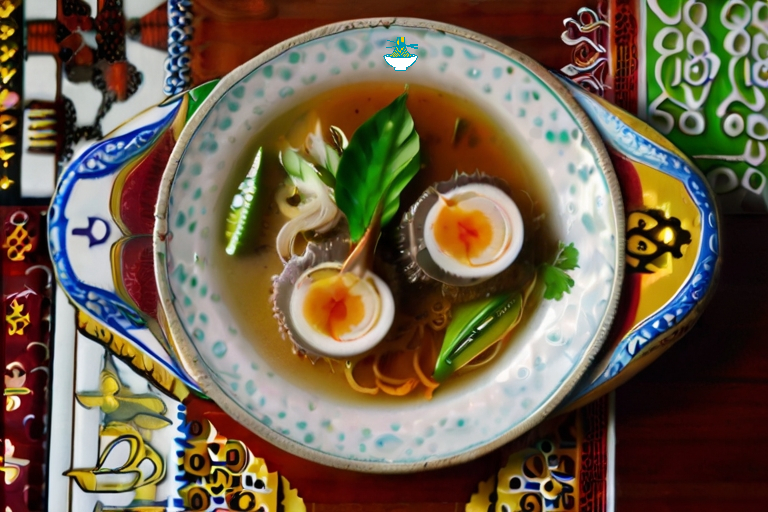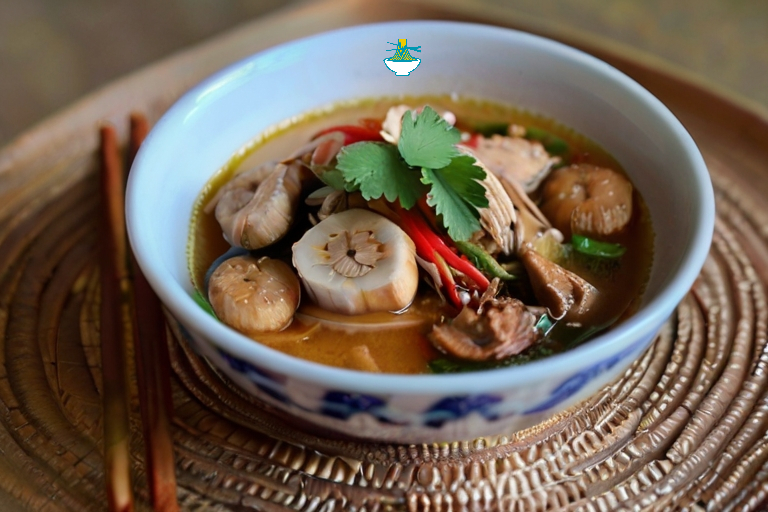Embark on a culinary adventure to Cambodia with the delectable Bai Sach Chrouk, a quintessential dish that epitomizes the rich flavors and cultural heritage of this Southeast Asian nation. Bai Sach Chrouk, translated as "pork and rice" in English, is a beloved traditional Cambodian breakfast dish enjoyed by locals and visitors alike. This dish seamlessly combines succulent marinated pork with fragrant rice, accompanied by a tantalizing array of accompaniments that elevate its taste to new heights.
In this recipe, we'll delve into the art of preparing Bai Sach Chrouk, guiding you through the intricate steps of marinating the pork to perfection and crafting the ideal accompaniments to complement its flavors. From the tender, caramelized pork to the aromatic rice and zesty pickled vegetables, each element of this dish contributes to its irresistible appeal.
Whether you're seeking to recreate the flavors of Cambodia in your own kitchen or simply craving a hearty and satisfying meal, this Bai Sach Chrouk recipe promises to transport your taste buds to the bustling streets of Phnom Penh or Siem Reap. Get ready to savor the authentic taste of Cambodian cuisine with this flavorful and aromatic dish!
Ingredients:
For the Grilled Pork:
- 500g pork loin or pork belly, thinly sliced
- 3 cloves garlic, minced
- 2 tablespoons soy sauce
- 1 tablespoon fish sauce
- 1 tablespoon oyster sauce
- 1 tablespoon sugar
- 1/2 teaspoon black pepper
- 1 tablespoon vegetable oil
For the Rice:
- 2 cups jasmine rice
- 3 cups water
For the Pickled Vegetables:
- 1 cup thinly sliced cucumbers
- 1 cup thinly sliced carrots
- 1/2 cup thinly sliced shallots or red onion
- 1/2 cup rice vinegar
- 2 tablespoons sugar
- 1 teaspoon salt
For Serving:
- Fresh lettuce leaves
- Fresh herbs such as cilantro and mint
- Lime wedges
- Chili sauce or sliced fresh chili (optional)
Instructions:
Marinate the Pork:
1- In a bowl, combine minced garlic, soy sauce, fish sauce, oyster sauce, sugar, and black pepper. Mix well until the sugar is dissolved.
2- Add the thinly sliced pork to the marinade, ensuring each piece is coated evenly. Let it marinate for at least 30 minutes, or ideally, refrigerate overnight for maximum flavor.
Prepare the Pickled Vegetables:
1- In a small bowl, mix rice vinegar, sugar, and salt until the sugar and salt are dissolved.
2- Place the sliced cucumbers, carrots, and shallots in a jar or bowl. Pour the vinegar mixture over the vegetables, ensuring they are fully submerged. Let them pickle for at least 30 minutes before serving.
Cook the Rice:
1- Rinse the jasmine rice under cold water until the water runs clear.
2- In a rice cooker or pot, combine the rinsed rice with water. Cook according to your rice cooker's instructions or bring to a boil, then reduce heat to low, cover, and simmer for 15-20 minutes until the rice is tender and the water is absorbed. Fluff the rice with a fork before serving.
Grill the Pork:
1- Heat a grill pan or skillet over medium-high heat. Add vegetable oil to the pan.
2- Once the pan is hot, add the marinated pork slices in a single layer, working in batches if necessary.
3- Grill the pork for 2-3 minutes on each side until caramelized and cooked through. Remove from the pan and set aside.
Assemble the Dish:
1- Place a generous portion of cooked rice on each plate.
2- Arrange the grilled pork slices on top of the rice.
3- Serve with fresh lettuce leaves, pickled vegetables, fresh herbs, lime wedges, and chili sauce on the side.
4- To enjoy, wrap a piece of grilled pork and some pickled vegetables in a lettuce leaf, squeeze some lime juice over it, add fresh herbs, and a dollop of chili sauce if desired. Enjoy the burst of flavors!
This authentic Cambodian Bai Sach Chrouk is a delightful combination of tender grilled pork, fragrant rice, and tangy pickled vegetables, offering a symphony of flavors and textures that will transport you to the vibrant streets of Cambodia with every bite.
Nutritional Values:
Here are the approximate nutritional values for the listed ingredients per serving:
Pork loin or pork belly (100g):
- Calories: 250-300 kcal
- Protein: 15-20g
- Fat: 20-25g
- Carbohydrates: 0g
benefits: Good source of protein and essential nutrients like iron and B vitamins.
Garlic (3 cloves):
- Calories: 13 kcal
- Protein: 0.6g
- Fat: 0.1g
- Carbohydrates: 3g
- Fiber: 0.2g
benefits: Contains compounds with potential health benefits, including immune-boosting properties and potential heart health benefits.
Soy sauce (2 tablespoons):
- Calories: 20 kcal
- Protein: 2g
- Fat: 0g
- Carbohydrates: 4g
benefits: Adds flavor to dishes and contains some protein while being lower in sodium compared to table salt.
Fish sauce (1 tablespoon):
- Calories: 15 kcal
- Protein: 3g
- Fat: 0g
- Carbohydrates: 1g
benefits: Enhances umami flavor in dishes and adds depth of flavor, rich in protein and minerals.
Oyster sauce (1 tablespoon):
- Calories: 15 kcal
- Protein: 1g
- Fat: 0g
- Carbohydrates: 3g
benefits: Adds a savory flavor to dishes and provides some protein and minerals.
Sugar (1 tablespoon):
- Calories: 50 kcal
- Carbohydrates: 13g
benefits: Provides quick energy but should be consumed in moderation to avoid negative health effects.
Black pepper (1/2 teaspoon):
- Calories: 3 kcal
- Carbohydrates: 0.7g
benefits: Contains piperine, which may have antioxidant and anti-inflammatory properties.
Vegetable oil (1 tablespoon):
- Calories: 120 kcal
- Fat: 14g
benefits: Provides healthy fats and vitamin E, important for skin health and overall well-being.
Jasmine rice (1 cup cooked):
- Calories: 205 kcal
- Protein: 4.3g
- Fat: 0.4g
- Carbohydrates: 45g
benefits: A good source of carbohydrates for energy and provides some protein and essential nutrients like B vitamins.
Cucumbers (1 cup sliced):
- Calories: 16 kcal
- Protein: 0.8g
- Fat: 0.2g
- Carbohydrates: 3.6g
- Fiber: 0.5g
benefits: Hydrating and low in calories, cucumbers are also a good source of antioxidants and may aid in digestion.
Carrots (1 cup sliced):
- Calories: 52 kcal
- Protein: 1.2g
- Fat: 0.3g
- Carbohydrates: 12g
- Fiber: 3.6g
benefits: Rich in beta-carotene, a precursor to vitamin A, and fiber, carrots promote eye health and aid digestion.
Shallots or red onion (1/2 cup sliced):
- Calories: 32 kcal
- Protein: 0.8g
- Fat: 0.1g
- Carbohydrates: 7.5g
- Fiber: 1.4g
benefits: Contains antioxidants and compounds that may benefit heart health and boost the immune system.
Rice vinegar (1/2 cup):
- Calories: 24 kcal
- Carbohydrates: 0.6g
benefits: Adds tanginess to dishes and may have some health benefits, including aiding digestion and promoting satiety.
Fresh lettuce leaves:
- Calories: 5 kcal
- Protein: 0.5g
- Fat: 0g
- Carbohydrates: 1g
- Fiber: 0.5g
benefits: Low in calories and high in water content, lettuce leaves are a good source of vitamins and minerals.
Fresh herbs (cilantro and mint):
- Negligible calories, protein, fat, and carbohydrates.
benefits: Rich in antioxidants and vitamins, fresh herbs add flavor and may have anti-inflammatory properties.
Lime wedges:
- Calories: 8 kcal
- Carbohydrates: 3g
benefits: Excellent source of vitamin C and antioxidants, lime juice enhances flavor and aids in digestion.
Chili sauce or sliced fresh chili (optional):
- Calories: Varies based on type and quantity, typically low in calories with minimal protein, fat, and carbohydrates.
benefits: Contains capsaicin, which may boost metabolism and have anti-inflammatory effects when consumed in moderation.
Please note that these values are approximate and can vary based on factors such as brands, preparation methods, and specific ingredients used.


Comments